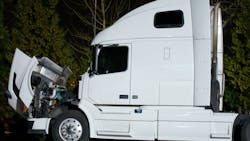Making correct asset replacement decisions is vital
It has become increasingly important that fleet managers have complete information on how each asset in their fleet is performing. Each year, most fleets have a set number of trucks they trade in for new vehicles from their chosen manufacturer. Typically, age and given all the choices or miles are the determining factors in which assets to replace.
However, the current truck market is anything but typical. A fleet may only receive a fraction of the trucks they order in 2023, and the delivery may be dispersed across the entire year.
See also: Finance sources should be strategic partners for fleets
That makes the decision about which assets to retire critical. The good news is that technology allows fleets to have a detailed picture of how each asset is performing. Data from telematics devices coupled with maintenance and repair records can help fleet managers gain a better understanding of the condition of each asset in the fleet.
Fleet managers need to look at how many miles (or hours, depending on duty cycle) a truck has accumulated. Beyond that, it needs to look at how those miles were accumulated. Did the truck spend most of the time over the road at highway speeds, or was it in stop-and-go urban delivery applications?
Fleet managers also need to take a deep dive into the truck’s preventive maintenance and repair history. Was the truck in the shop only for scheduled maintenance appointments, or did it have to go in for additional mechanical services? The need for additional repairs outside a normal maintenance schedule should be investigated to determine the root cause. Breakdown trends also need to be reviewed.
The total cost of operation (TCO) needs to be calculated for each asset and an attempt needs to be made—based on historical data—to calculate what the total cost will be to keep a particular asset operating for another year or longer. In addition to maintenance and repair costs, the TCO calculation needs to include fuel costs—which will be based on how efficient the truck is to operate.
See also: Business intelligence means better decisions for fleets
Of course, there are also soft factors to consider, including driver satisfaction. Drivers want to be behind the wheel of trucks they know will run well and that have certain creature comforts. While it can be difficult to put a price tag on driver satisfaction, don’t overlook it when making the asset replacement decision.
While most fleets won't be able to avoid running older trucks at least through next year, selecting the right trucks to replace will be essential to maintaining fleet profitability until we return to a more normal production—and therefore asset replacement—environment.
Patrick Gaskins, SVP of Corcentric Fleet Solutions, oversees both sales and operations for the company's fleet offerings. Gaskins joined the company in 2010, bringing more than 30 years of experience as a financial services professional in the transportation industry. He leads a team that works with a supply base of more than 160 manufacturers to help the country’s largest fleets manage all aspects of their fleet operations and fleet-related spend.
About the Author

Patrick Gaskins
Senior vice president, Fleet Solutions
Pat Gaskins is the senior vice president of Corcentric Fleet Solutions, where he leads both the sales and operations teams for the company’s fleet offerings. He has over 30 years of experience as a financial services professional in the transportation industry and manages partnerships with over 160 manufacturers, helping over 2,000 of the country’s largest fleets manage all aspects of their fleet operations and fleet-related spend.
